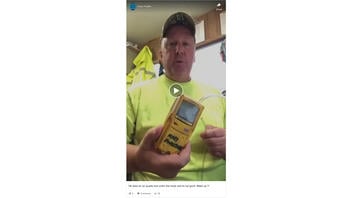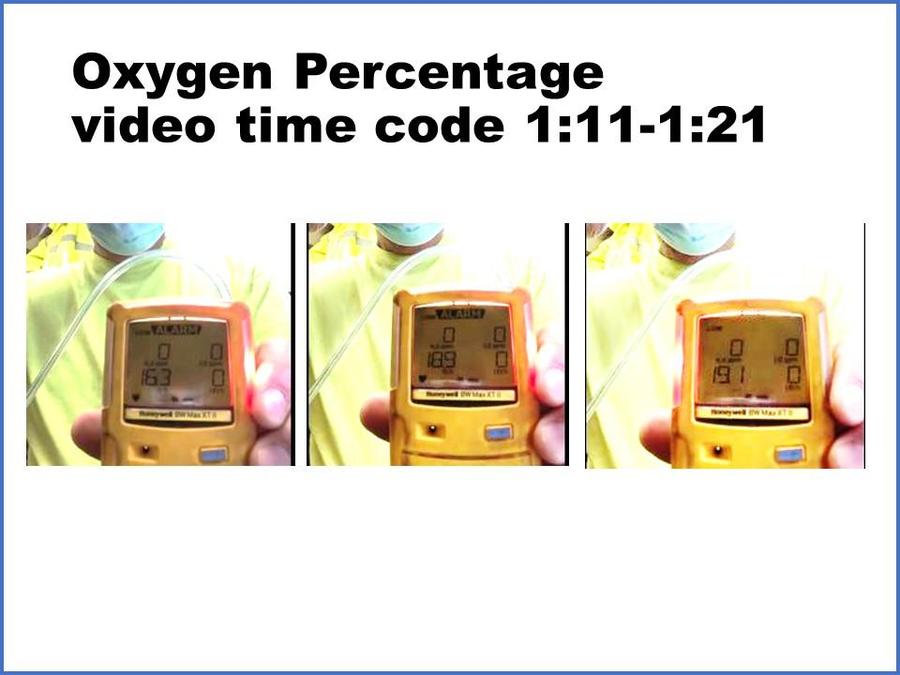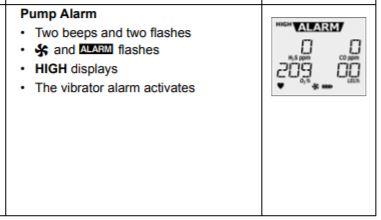STORY UPDATED: check for updates below.

Does this video of an air quality monitor's danger signal prove it is unhealthy to wear one of the surgical masks recommended to slow the spread of COVID-19? No, that's not true: The screen on the gadget in the video, according to the user manual and an instructional video for the Honeywell device, indicates either a fault with the device or that the man in the video was breathing directly into the air monitor intake tube. The manufacturer of the device said it is not properly used in the video and the result cannot be interpreted as it is in the video.
The Centers for Disease Control and Prevention (CDC) has published multiple scientific studies indicating surgical masks are safe. Tens of thousands of surgeons, nurses and operating room staff wear them daily. The consensus of public health research is that mask-wearing protects the mask-wearer from breathing in viruses carried through the air by tiny water droplets and reduces the spread of disease by curtailing droplets breathed out.
The claim circulated in a number of social media posts, including this September 5, 2021, Facebook post (archived here) under the title: "He does an air quality test under the mask and it's not good." The person in the video says
It is not safe for you. It is not safe for your children to wear that mask all day long.
This is what the post looked like on Facebook at the time of writing:
(Source: Facebook screenshot taken on Wed Sep 22 19:34:25 2021 UTC)
The device shown in the video is a Honeywell GasAlert Max XT II Confined Space Multi-Gas Monitor. Construction workers, utility workers and others who work below ground or in other confined spaces are often required to wear them and to evacuate when the monitor alerts them the air is unsafe. The man in the video identifies himself as an electrician.
The monitor uses an air pump to draw air past three sensors, checking for unsafe levels of suffocating carbon monoxide, poisonous and corrosive hydrogen sulfide and flammable methane. The fourth sensor is tuned to check that oxygen levels are above the 19.5% legal limit for safe workspaces. When a plastic tube is attached, the monitor can be poked into workspaces to spot-check air quality. When the front cover is unsealed, it tests ambient air quality around a worker.
The device is not designed to test gases in the way it is used in the video, Honeywell's public relations specialist for safety products wrote in a September 23, 2021, email to Lead Stories. He explained why:
As we exhale, we have decreased oxygen levels and naturally emit CO2 that dissipates into the atmosphere and away from our immediate breathing space. The closer the sample air pump is to the mouth the more concentrated the air sample will be with naturally forming gasses. Any monitoring inside a N95, surgical or fabric mask, as shown in this video, would produce a false alarm on any gas meter because exhaled air is being slightly confined inside the mask.
According to the Centers for Disease Control, cloth and surgical masks do not provide an airtight fit across the face, allowing exhaled air to escape through the mask when a person breathes or talks. For more information on proper mask wearing and the type of masks to wear, please see the CDC site.
The CDC has published a list of 19 studies that prove mask-wearing -- especially in concert with social distancing -- slows the spread of COVID-19, by reducing people's exposure to airborne viruses. Lead Stories had, as of this writing, checked three dozen claims that masks do not work and found none are supported by the preponderance of research and the consensus of respiratory and occupational safety experts.
Given that masks work and are not a health hazard, there are several likely explanations for the blaring alarm and flashing alerts that go off when the man in the video puts the air monitoring device's intake tube under his surgical mask:
1. Breathing directly into the air intake would deliver air with 16% oxygen, setting off the alarm
Textbooks say the air on Earth generally contains 21% oxygen and that the expelled breath of a human contains 16% oxygen. When the man in the video slides the tube under his mask, the screen on the monitor fluctuates between 16.3% oxygen and 19.1% as he breathes in and out and speaks with the intake tube positioned by his mouth, as shown in the following montage of screengrabs from the video.
(Source: Facebook screenshots taken Thu Sept 22 03:35:00 2021 UTC)2. Loosening the cover would cause the kind of alert shown in the video
When not using the testing tube to spot-check a workspace, the user can open the front case, which breaks a seal over the sensors and lets the air monitor test ambient air around the device. At the 4:16 mark of this instructional video by a safety equipment company, the monitor is shown blasting its alerts when the case is opened, a precaution to be sure the user knows if they are in tube spot-checking mode or ambient air sensing mode.
3. The device may be damaged
Although unlikely, since it appears to be functioning correctly before the tube is placed under the mask, an unscrupulous video editor could easily splice video of the working device to video in which the man has replaced it with a broken device and make it look like only one device was used.
The user manual for the Howell air monitor shows the type of alert generated when the air pump is malfunctioning. The screen display closely resembles the display shown in the video making mask claims.
(Source: Honeywell user manual screenshot taken Wed Sept 22 22:20:23 2021 UTC)
Lead Stories asked the International Brotherhood of Electrical Workers safety staff and two companies that sell the device to review the video and comment on what it shows. We will update this fact check when they reply.
Updates:
-
2021-09-23T21:41:13Z 2021-09-23T21:41:13Z Updated to include sensor manufacturer's explanation why the monitor can't be used to prove masks are dangerous.


















